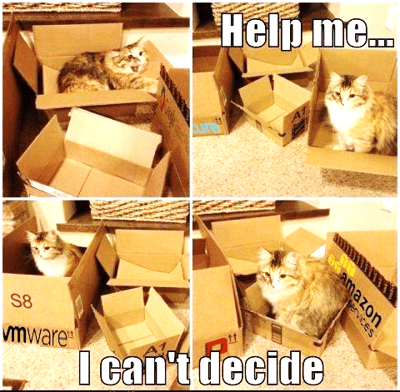If you’re an IT administrator, there are good and bad ways to offer cloud services to your end users. Get it right and your customers purr contentedly. Get it wrong and you get a claw to the face. Here’s what to watch for.
1. Taking Too Long
(“Where the @%#$’s my server?”)

Been to a restaurant lately? How do you feel if you can’t get a server? The same applies to the IT end-users. Do they want to wait weeks for servers? No!
Why not let users serve themselves? Better still, why not give them all they can eat?
2. Being TOO Cloudy (Not being the broker)

Public clouds are very powerful tools that enable business agility. But as a cloud consumer, you have an important choice to make. If you choose to use a single cloud provider, you end up locked into their services and UI. If you use multiple clouds, you must master multiple toolsets and UIs so that much of the agility is lost.
You can get the best of both worlds by deploying a Cloud Management Platform. This makes you a services broker and allows you to leverage the power of hybrid cloud from a single UI.
3. Making Manual Mistakes

Fulfilling requests by hand takes time, which irritates the requestor. Manual entry is also prone to fat fingering, resulting in VMs that are incorrectly provisioned. The same goes for tracking costs.
Automating VM builds takes mistakes out of the picture. Why provision systems by hand when a cloud management platform can do the job automatically, from a single UI?
4. Leaving Money on the Table (or in the cushions)

To paraphrase management wisdom, you can’t charge for what you can’t measure. Call it what you like – chargeback, showback, shameback – but you’re making a mistake if you don’t track your cloud costs.
Cloud management platforms can track costs for you and your users automatically.
5. Losing Your Control

You are asking for trouble if you can’t quickly and easily answer these 5 questions:
- Who owns the system?
- Where it is deployed?
- Why does it exist?
- How long does it need to exist?
- How much does it cost to run?
Just like a bank, you must have clear visibility of assets.
Be sure to choose management tools that enable you to answer these questions.
6. Living Below the Clouds

The one who lives above the cloud, reigns. Don’t lock yourself into one vendor. Build a provider-agnostic environment that allows you to standardize IT, introduce new technologies, and transition between clouds without your end-users even knowing.
Make sure you’re able to choose the right cloud for each job. One size does not fit all.
7. Being the Worker Bee, Not the Queen Bee

The Queen Bee empowers her Worker Bees to do everything on their own. The same applies to IT admins and end users. IT need to empower their end users to build and manage their own environments while still maintaining oversight of security, capacity, and performance.
By empowering end users, IT can save time and money. And, most importantly, it makes IT an enabler rather than a barrier.

